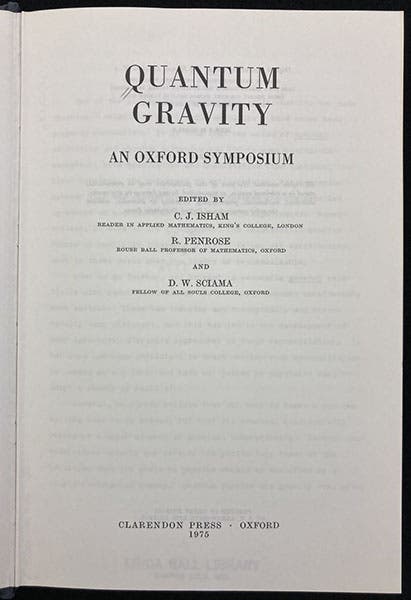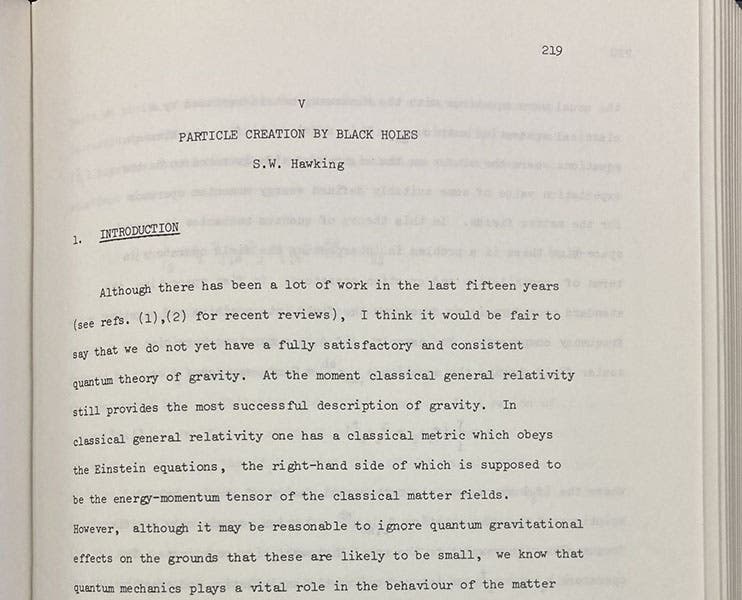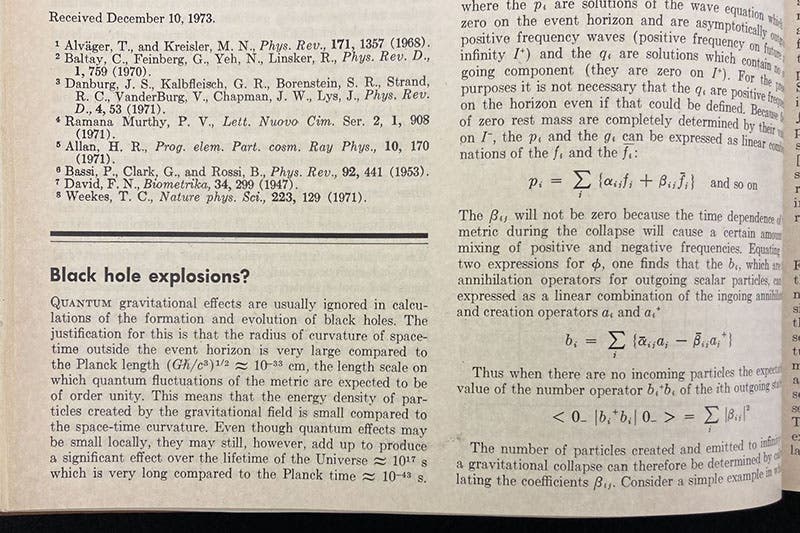Scientist of the Day - Stephen Hawking
On Valentine’s Day, Feb. 14, 1974, so the story goes, Stephen W. Hawking was wheeled into a meeting room at the Rutherford Appleton Laboratory south of Oxford, where they were having a symposium on quantum gravity. Hawking was a member of the Dept. of Applied Mathematics and Theoretical Physics at Cambridge. He was 32 years old. Twelve years earlier, he had been diagnosed with ALS, but the disease was progressing more slowly than predicted, and although he was now confined to a wheelchair, his mind remained fully functional (as it would until his death, 44 years later).
Hawking had been working on black holes for some time, although they were thought to be fairly well understood. A black hole is a singularity of space and time; it has mass, charge, and angular momentum, but no other attributes. The individual features of whatever goes into a black hole, be it a collapsing star or a plethora of kitchen sinks, are wiped out in the black hole. "A black hole has no hair" is the way this was put by the American physicist John Wheeler, who had a way with phrases (he coined the very term black hole in 1967). A black hole is surrounded by an "event horizon", and anything that crosses the event horizon has entered on a one-way street from which there is no return. Nothing, not even light, can escape from a black hole. Or so it was thought.
Hawking decided to apply quantum mechanics to black holes. In the quantum world, funny things can happen. For example, a particle and its antiparticle might spontaneously appear out of nothing, and then disappear; the energy for this is available in the quantum world, provided the time interval is short. But, Hawking wondered, what if a pair of virtual particles were created just outside the event horizon of a black hole? One of the created particles might disappear over the event horizon and would be unable to reunite with its counterpart. The lone survivor would then zip away, carrying energy. To the observer, it would look like the particle had come out of the black hole, and that the black hole was radiating energy. That was the gist of Hawking's paper, which was titled: “Particle creation by black holes” (third image). Black holes are not necessarily prisons of light; they can leak. In fact, the smaller ones should be able to radiate themselves out of existence.
The reaction that day was memorable, or so it has been said. The chairman of the session, a respected physicist, supposedly declared Hawking's paper to be rubbish. No one believed Hawking’s claims. Hawking was threatening to turn the world of black-hole research inside out, and the home team was resisting.
So that is the legend of Hawking’s Valentine’s Day paper. It was told essentially this way by Hawking himself, and his first wife Jane, in a PBS documentary in 2014, which you can watch on YouTube here. Discussion of the Oxford paper starts at the 25:36 mark (and lasts about 3 minutes). Since I am cursed with historical training, I naturally checked this out. I found the Proceedings of the symposium on our Library shelves (second image), and in the introduction, the conveners say that the symposium was held Feb. 15-16, 1974, which would have been a Friday and Saturday, the days after Valentine’s Day. However, Hawking most definitely remembers it as a Valentine’s Day event, as you can hear in the PBS interview. Who are you going to believe, the historical record, or a mathematical genius? I am with Hawking. As for the view that no one at the symposium believed Hawking, we have only Jane’s word for that, and there is no evidence that she was even there (although she might well have been).
The legend notwithstanding, Hawking most definitely published a paper in Nature on exploding black holes two weeks after the conference. We show here details of both pages of that brief but brilliant article (fifth and sixth images). It resulted in the almost immediate election of Hawking to a fellowship in the Royal Society of London. Not surprisingly, Hawking turned out to be right, and his predicted black-hole radiation is now an accepted part of black-hole physics, and it is even called Hawking radiation. Dennis Sciama, one of the conveners of the Oxford meeting, later declared (perhaps a bit extravagantly) that Hawking’s paper in Nature “was the most beautiful paper in the history of physics.”
In 1979, Hawking was chosen to fill the Lucasian Chair of Mathematics at the University of Cambridge, the chair made famous by previous occupants such as Isaac Newton, Charles Babbage, and Paul Dirac. We wrote a post on Lucas and his endowment just last month. In a future post, we will have more to say about Hawking’s later career.
William B. Ashworth, Jr., Consultant for the History of Science, Linda Hall Library and Associate Professor emeritus, Department of History, University of Missouri-Kansas City. Comments or corrections are welcome; please direct to ashworthw@umkc.edu.












